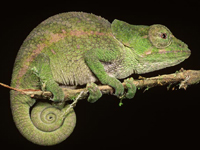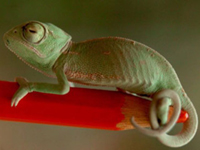

 |

|
 Common Chameleon |
Common Chameleon(Reptile) |
 Common Chameleon Baby |
Common Chameleon HabitsThe common chameleon lives in the forests along the coast of North Africa extending to the Middle East and along the coast of southern Spain. It spends most of the day motionless in the trees, waiting for unsuspecting insects and spiders to pass by.
The chameleon's ability to change color it is its primary defense against predators.
Each chameleon has basic color which broadly matches its habitat. Changes in its color are subtle and correspond to changes in light and shadows.
Beneath its transparent skin, the chameleon has red and yellow color cells that reflect the blue and white layers bellow them. Under these layers is yet another layer of brown pigment. Color changes occur when the color cells become larger or smaller, regulating the amount of multicolored reflection each layer produces. |
Common Chameleon CommunicationInstead of vocalizing or using pheromones, chameleons communicate visually by changing the colors and patterns of their skin. Different colors and patterns mean different thingssimilar to how the colors of a traffic light direct drivers.
For example, the brighter colors a male displays, the more dominant he is. So male chameleons can attract a mate or defend their territory by flashing bright colors to each other. To communicate submission or surrender, a male will display drab browns and grays.
Females also use a colorful version of signaling to communicate when they want to reject mates or when they are pregnant. |
Common Chameleon BreedingThe chameleon leads a solitary existence and will seek out the company of other chameleons only during the breeding season. The male guards his territory fiercely against rival males and frightens them off by inflating his lungs and puffing up his body.
Mating takes place in the trees, during which time the female's eggs are fertilized inside he r body. When she is ready to ay her eggs in the late summer, the female chooses a warm spot at the base of a tree she deposits up to thirty eggs.
After covering them with soil, she returns to the treetops and leaves the eggs to develop unattended. Inside its shell, each young chameleon feeds on the yolk sac, the same way in which a hen's chicks does. When it is ready to hatch in the following spring, the yong breaks out of its shell with the use of its egg tooth. When it is hatched, the young chameleon looks like smaller version of its parents. |
Common Chameleon Food & FeedingThe chameleon is a master of the disguise. It can change color to blend in with its surroundings and is unrecognizable to the spiders and insects it caches.
Without moving its body, the chameleon uses its eyes to locate prey. Once it spots its prey, the chameleon flicks out its sticky tongue and catches the insect.Fully extended, the chameleon's tongue is as long as its body.
The chameleon's ability to change color also helps it to stay hidden from its predators. |
Common Chameleon Key Facts |
| Size |
| Height: Length: 8-12 inches. Tail length: As long as head & body. Tongue length: As long as head & body |
| Weight: Varies greatly, between 1/2 pound and 10 pounds |
| Breeding |
| Sexual maturity: 1 year |
| Mating: Late summer |
| Gestation: Young emerge the following spring after they are laid on the ground |
| Number of young: 20-30 laid on the ground |
| Lifestyle |
| Habit: Solitary except during breeding season. They are daytime hunters |
| Diet: Almost all insects and spiders |
| Lifespan: Varies greatly between 3-10 years |
DID YOU KNOW?
|
CAN'T FIND WHAT YOU'RE LOOKING FOR? CLICK HERE!!!